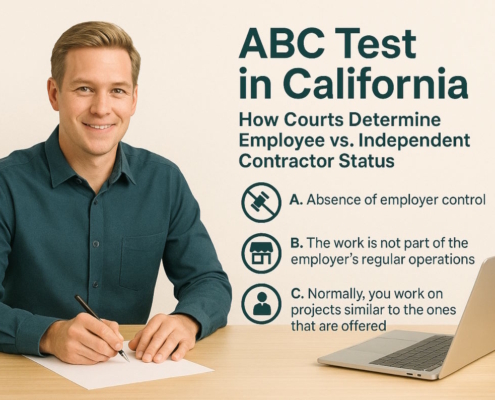Introduction
Determining whether a worker is an independent contractor or an employee is an important legal and financial issue for both businesses and workers. This classification affects everything from tax obligations and benefits to legal protections and wage rights. In California, the law presumes that a worker is an employee unless the hiring entity can prove otherwise by meeting specific legal requirements. The most commonly used standard is the ABC test, which sets out clear criteria to distinguish between employees and independent contractors. Understanding how this test works is essential for making sure the classification is legal and accurate.
What is the ABC test?
The Dynamex decision refers to a landmark case in California, Dynamex Operations West, Inc. v. Superior Court of Los Angeles, that was litigated by employment lawyers in Los Angeles to California Supreme Court in April 2018. In this case, the court established a new test, known as the ABC test, for determining whether a worker should be classified as an employee or an independent contractor under the California Wage Orders, which cover wage and hour laws, including minimum wage and overtime.
The ABC test sets forth three criteria, all of which must be satisfied for a worker to be considered an independent contractor:
A) The worker is free from the control and direction of the hiring entity in connection with the performance of the work, both under the contract and in fact.
B) The worker performs work that is outside the usual course of the hiring entity’s business.
C) The worker is customarily engaged in an independently established trade, occupation, or business of the same nature as the work performed.
If any of these criteria is not met, the worker is generally considered an employee and is entitled to employee benefits and protections.
AB5, also known as the California Assembly Bill 5, was signed into law in September 2019 and codified the ABC test from the Dynamex decision into California law. The law aimed to address concerns about worker misclassification and to provide greater protections and benefits to workers who were classified as independent contractors but functioned more like employees. AB5 outlined specific industries and professions that were subject to the ABC test, and it made it more difficult for employers to classify workers as independent contractors.
AB5 also included exemptions for certain professions and industries, allowing them to continue using the previous classification standards until January 1, 2023, when the ABC test would apply more broadly. However, it faced criticism and pushback from various industries and led to discussions about worker classification and the gig economy.
Vasquez v. Jan-Pro Franchising International, Inc. is a legal case that dealt with the application of the ABC test and the classification of workers in the context of franchise relationships. In May 2019, the Ninth Circuit Court of Appeals issued a decision in this case that stated the ABC test retroactively applied to the case, changing the classification of certain franchisees from independent contractors to employees. This decision had implications for the franchising industry and raised questions about the potential impact of the ABC test on similar business models.
How Is the ABC Test Applied to determine independent contractor vs employee?
To apply the ABC test to a worker status as independent contractor vs employee, the following steps need to be taken:
- Find out whether the worker is free to control and direct the work they do, including if they are under a contract for getting some specific work done. The person hiring someone will have to demonstrate that a worker is free from this type of control. If they are under the control of the hiring entity in this kind of way, they will be classified as an employee. This satisfies part A of the ABC test.
- Find out whether the worker conducts any sort of work that falls outside of what the hiring entity does. This entity will have to provide evidence of some kind that proves the worker is doing something that is outside of the normal business operations that entity is involved with. This satisfies part B of the ABC test.
- Find out whether the worker is usually involved in the same type of business or work independent of the hiring entity. This entity will have to prove that the worker is regularly conducting the same type of work independent of the entity. They will have to prove there is a functioning independent business in operation at the time of the worker working for the hiring entity’s business. This satisfies part C of the ABC test. If a worker is dependent primarily on the work they do for a hiring manager, then this requirement is not met.
The ABC test will often determine a worker’s status as independent contractor or employee.
Is the ABC Test Required in All Cases?
The ABC is not required in every situation in determining independent contractor vs employee. There are times when it will definitely not apply. These are the following:
- The Legislature or the Industrial Welfare Commission (IWC) has specified that an employment relationship is a specific kind. In this type of situation, the ABC test does not apply in order to figure out what a worker’s status or liability are. Instead, the specific language used in IWC’s wage orders, the Labor Code, and the Unemployment Insurance Code will apply.
- A court of law will decide that the ABC test is not applicable for a specific reason, barring the Borello test, which we will elaborate on a little later.
- There are specific occupations and contracting relationships where the ABC test will not apply. These can be understood by using the Borello test, which we will get into now.
What Is the Borello Test in determining independent contractor vs employee?
In 1989, the California Supreme Court made a decision that established what came to be known as the Borello test. In the case of S.G. Borello & Sons, Inc. v. Dept. of Industrial Relations (1989) 48 Cal.3d 341, this Borello test was designed to use several factors to determine an independent contractor vs employee. The factors included whether a potential employer had the type of control they needed to achieve the results they wanted. This control did not have to be direct or detailed. The following had to be considered in the Borello test:
- It a worker considers themselves as someone who performs work that is unrelated to the work they conduct for the employer.
- If the work a worker performs is a normal and crucial aspect of their employer’s business.
- If either a worker or their employer provides various tools and support that are helpful in performing the job better.
- If a worker has made some sort of investment into the company they are working for, which can include equipment and tools necessary to perform their assigned tasks.
- If the work they provide their employer necessitates the use of a special skill.
- If a worker hires employees of their own.
- If a worker has the authority to terminate other workers whenever they want, or if their being terminated brings up breach of contract issues.
- Whether or not the worker and their employee-to-be both believe that they are forming a working relationship.
- What the type of occupation is and whether the work performed with be normally performed, under the guidance of an employer or a specialist where there is no supervision.
- Whether there is an opportunity to turn a profit or incur a loss, dependant on what the managerial skill is.
- What the amount of time is for the services that are going to be done.
- How permanent a working relationship would be.
- What the way of getting paid is. This could be either the amount of time they work or calculated by completing specific jobs.
The Borello test is considered to be a “multifactor” test for determining a worker’s status as an independent contractor vs employee. There is no single factor that title the balance in independent contractor vs employee. Courts have placed emphasis on the various factors within the test that are dependent on the particular circumstances.
The California Supreme Court clarified that the Borello test, “emphasizes statutory purpose as the touchstone for deciding whether a particular category of workers should be considered employees rather than independent contractors for purposes of social welfare legislation.” The Borello test emphasizes statutory purpose. In doing so, it gets used for identifying what workers are employees and which ones are independent contractors.
When comparing independent contractor vs employee, what are the similarities and differences between the ABC and Borello Tests?
The similarity between the Borello test and the ABC test is that they both go under the assumption that a worker is an employee. The hiring entity bears the burden of proof concerning whether the worker is an independent contractor vs employee.
There is a key difference between these two tests. The ABC test is designed so that both a business and a worker can easily figure out the distinction. They can figure out, ahead of time, whether that worker is an employee or independent contractor. This makes the ABC test more predictable than the process of determination used by the Borello test.
Contrary to the ABC test, when using the Borello test, there is no one factor that can prove if a worker is either an employee or independent contractor. When it comes to the courts, everything and anything that may prove relevant is considered on a case-by-case basis. This is in regards to what kind of work it is, as well as what the overall agreed-upon arrangement is.
Do Both AB 5 and the Labor Code Require Using the ABC Test?
Both AB 5 and the Labor Code do not require using the ABC test to ascertain the status of a worker. This is concerning any job within the state of California. The ABC test does apply to many jobs in California. However, there are some jobs where the Borello test is used instead as a determinant of the status of a worker. There are also certain jobs where the Borello test can be used instead of the ABC test. However, the hiring entity would have to fulfill additional requirements initially.
The types of occupations where the Borello test can be used instead of the ABC test are the following:
- Some insurance agents and brokers
- Some physicians, surgeons, dentists, podiatrists, psychologists, and veterinarians
- Some attorneys, architects, engineers, private investigators, and accountants
- Some securities brokers, investment advisors, as well as the agents and representatives working with them
- Some individuals involved in direct sales
- Some commercial fishers (until 12/31/22 without a legislative extension)
- Some newspaper distributors or carriers (until 12/31/20 without a legislative extension)
There are certain types of occupations or contractual agreements where more requirements have to be met. This is in regards to using of the Borello test rather than the ABC test. These requirements are the following. These involve contracts where there is a use of professional services.
- Marketing
- Human Resources Administration
- Travel Agents
- Graphic Design
- Grant Writers
- Fine Art Artists
- Enrolled Agents
- Payment Processing Agents
- Photojournalists & Photographers of Still Life
- Freelance Writers, Editors, and Cartoonists for Newspapers
- Licensed Barbers
- Cosmetologists
- Electrologists
- Estheticians
- Manicurists (up until 12/31/21)
For these professional services, the Borello test is applicable. It will ascertain whether a worker is an employee if requirements necessary to be met are met.
In addition, particular workers who are conducting work under a subcontract within the construction industry will have the Borello test apply. The Labor Code section 2750.5 will also be applicable. This is to determine whether the worker is an employee of a particular contractor, if requirements will be met.
There are also some providers of services who receive business thanks to referrals. The services these individuals provide are the following:
- Graphic Design
- Web Design
- Photography
- Tutoring
- Event Planning
- Minor Home Repair
- Moving
- House Cleaning
- Furniture Assembly
- Animal Services
- Dog Walking & Grooming
- Pool Cleaning
- Yard Cleanup
In all of these cases, the Borello test is used to ascertain if a provider of any of these services is an employee. This is in regards to them being an employee of the party that has referred them.
There are also particular workers who conduct services in connection with a contract initiated by a third party. The type of third party being referred to here is a motor club that offers services related to motor vehicles. The Borello test would apply in this case to ascertain if an individual is an employee of the club.
There are some bona fide business-to-business (B2B) relationships under contract where the Borello test is applicable. The test in these cases will ascertain if a business offering particular services is an employee of another company contracting for services.
There are two industries in particular that require closer scrutiny. This involves special rules found within the Labor Code section 2750.3. According to the Business and Professions Code, the following industries have to abide by additional rules:
- Some individuals in possession of a real estate license will succumb to additional rules. These individuals are governed by a test of their status as either an employee or independent contractor. Section 10032(b) of the Business and Professions Code will be applicable. If, for some reason, it is not, the Borello test will have to be applied. However, starting on 7/1/20, the ABC test will apply in the area of workers’ compensation.
- Some repossession agencies will succumb to additional rules. The individuals within these agencies will be governed by Section 7500.2 of the Business and Professions Code.
There will sometimes be rather complex rules involved when some industries, occupations, and contracting relationships are exempt from the ABC test. Whenever in doubt, employers and workers alike will benefit from seeking independent advice. This should be done if they are unsure about whether any exemptions apply to their unique situations.
Does AB 5 Automatically Reclassify Workers as Employees?
AB 5 does not reclassify workers automatically. In the Labor Code section 2750.3, it is assumed that all workers, regardless of who they are, will be considered employees. In this section, there is a test that ensures a hiring entity satisfies the requirements for proving a worker is an independent contractor. A hiring entity has the ability to review working arrangement and make sure they are properly classifying their workers. If they are not doing so, as the law requires, a worker has the option of filing. This is in the event that a worker believes they are being misclassified as an independent contractor.
Is a Worker an Independent Contractor If They Sign a Statement Saying That?
A hiring entity may sometimes require their workers to sign an agreement that states that they are employed as independent contractors. This would mean there will be no payroll deductions or withholdings for either taxes or Social Security. When the year ends, the hiring entity gives the workers the IRS Form 1099 instead of a W-2. However, any such signed agreement is not valid.
Simply being labeled as an independent contractor because a worker signed something a hiring entity told them to sign is not a determinant of employment status. The ABC test or Borello test, as well as any standard within the Labor Code section 2750.3 would be used as a determinant. A hiring entity does not have the power to change someone’s employment status from employee to independent contractor. This includes using a written agreement or giving the worker IRS Form 1099.
Are There Penalties When A Hiring Entity Misclassifies Workers as Independent Contractors?
Yes, there are certain penalties involved. There many be penalties assessed if there are violations of wage laws when a worker is misclassified. There are civil penalties that involve the intentional misclassification of a worker. Labor Code section 226.8 does not allow intentional misclassification of workers as independent contractors. The penalties run between $5,000 and $25,000 for each violation. The intentional misclassification referred to here is defined as voluntarily and knowingly misclassifying a worker as an independent contractor.
What Is the Difference Between a Worker Being an Employee and Independent Contractor?
In the state of California, wage and hour laws protect employees. Independent contractors have no such protections. The laws involved here are the following:
- Minimum Wage Laws
- Overtime Laws
- Meal Periods Laws
- Rest Breaks Laws
- Workplace Safety Laws
- Retaliation Laws
An employee is also able to go to a state agency, such as the Labor Commissioner’s Office, to have these laws enforced. Independent contractors have to resolve disputes on their own, figuring out other ways of resolving issues with their hiring entity.
Do AB 5 and Labor Code section 2750.3 Also Apply to the Public Sector?
Yes, they do. However, there are many exceptions. Certain parts of the Labor Code, as well as the majority of other IWC Wage Orders, are not applicable to employees in the public sector. AB 5 has not made any changes in regards to the public sector for determining a worker’s status as an independent contractor vs employee.
Are AB 5 and Labor Code section 2750.3 Applicable to Volunteers and Interns?
No, they are not. In AB 5, the ABC test is only applied when it is unclear whether a worker is an independent contractor vs employee. When it comes to ascertaining whether a volunteer or intern is an employee or not, different standards are applicable.
What Can a Worker Do When Their Employer Regards Them as an Independent Contractor vs employee?
A worker has a few avenues they can take when they believe they are not being classified correctly. They can generate a wage claim with the office of the Labor Commissioner. They can also report a violation of labor laws with this Office. This includes a case where there are rampant violations that affect many workers. Finally, they can sue the employer and take them to court.
What Protections Exist When an Employer Retaliates Against Them?
There are sometimes situations where an employer retaliates against them because the worker complained about being incorrectly classified. This can lead to the worker losing rights employees have, such as payment for overtime. This can be considered either discrimination or retaliation. The worker has the ability to officially lodge a complaint with the office of the Labor Commissioner for being discriminated or retaliated against. However, the Labor Commissioner has no authority to get involved in a situation where a worker is actually an independent contractor. A worker can sue against the hiring entity if they do not want to file a complaint with the office of the Labor Commissioner.
Do Employers Have a Grace Period to Become Compliant After AB 5 Goes Into Effect?
There is no grace period for employers when it comes to paying payroll taxes due. They will be required to pay given the number of employees within their company as of 1/1/20. If an employer has not registered with EDD as a unit of employment, they should register and start to file and pay taxes owed.
How Does EDD Determine Employment Status When It Comes to Unemployment or State Disability Insurance Benefits?
EDD determines employment status by conducting an audit in regards to employment taxes. It can also make a determination on an Unemployment or State Disability Insurance benefits claim. When there was work that was done before 1/1/20, a worker’s employment status is decided by what the current provisions within the Unemployment Insurance Code section 621(b) are. This section demands EDD apply the Borello test to make a determination. When work has been done on or after 1/1/20, EDD determines a worker’s employment status differently. It looks at the results of the test noted within AB 5. When determining independent contractor vs employee, EDD now use the ABC test but not exclusively.
Any There Any Remaining Employment Exclusions After AB 5 Goes Into Effect?
Yes, there are. The Unemployment Insurance Code includes exclusions for some kinds of services from its definition of what employment is. This will affect a worker who is able to receive Unemployment Insurance benefits. Even after AB 5 becomes codified, these exclusions will stay in effect.
Will Employers Face Any Risks When They Don’t Accurately Classify Workers?
Yes, they do. If the EDD were to discover that a worker is being misclassified as an independent contractor instead of an employee, there are major risks. The hiring entity has certain obligations it must adhere to, according to the Unemployment Insurance Code. The risks include not paying enough for taxes owed and needing to pay the payroll taxes of their employees. Both of these risks can result in some rather high penalties and/or interest. The financial risks and harm is severe for an employer to categorize a worker as an independent contractor vs employee.
Are There Tax Implications When Workers Are Officially Considered Independent Contractors?
Yes, there are. Tax implications exist when a worker gets classified as an independent contractor. This is for federal and state tax purposes. There is an entity in the state of California that is responsible for the administration of personal income and franchise tax. The Franchise Tax Board, being this entity, offers guidance on answering this question. Depending on whether a worker is an employee or independent contract, different requirements to report taxes and file requirements are in place. The Franchise Tax Board has additional information on these requirements. For many employers, there are financial benefits for categorizing a worker as an independent contractor vs employee.
Are Workers Considered Employees in California if Federally They Are Not?
Yes, a worker can be considered to be an employee within the state of California, even if this is not the case when it comes to federal law. The reason for this is that tests which are utilized to ascertain employee status are different from those utilized when the federal law is considered. Federally, one way the determination of employee status is made is by using the Fair Labor Standards Act (FLSA). Federal laws complicates determining independent contractor vs employee.































